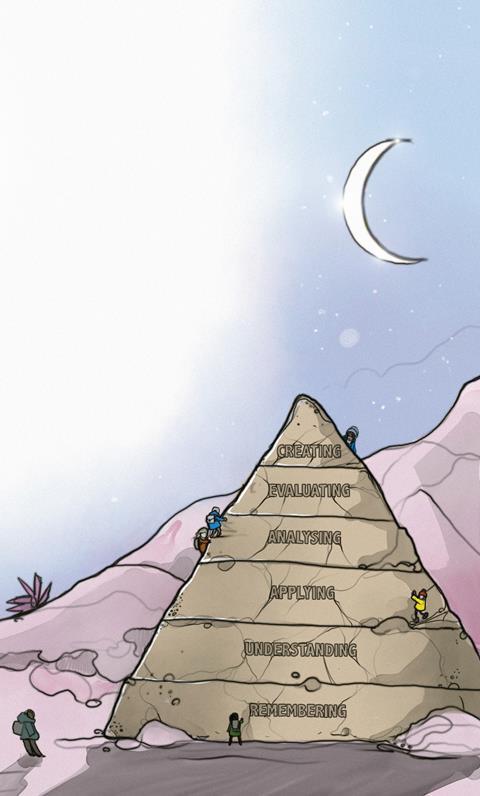Andy Chandler-Grevatt introduces threshold concept mastery tasks for A-level
A common concern for university lecturers is that undergraduates do not seem to understand or remember key concepts from A-level chemistry such as atomic structure, the mole and enthalpy. Some fundamental concepts are more difficult to learn than others and some concepts, once learnt, can enable students to understand further concepts. If there was a way to engage students with learning the more difficult concepts, perhaps the problem could be alleviated.

At a sixth form college in England, teachers embarked on a research project that attempted to do just that. In collaboration with an educational researcher, they developed tasks that combined identifying threshold concepts – the more difficult chemistry ideas – with a mastery approach. Biology, chemistry, physics and maths teachers developed threshold concept mastery (TCM) tasks that focused on this approach. This article focuses on some outcomes from this project, with specific examples taken from chemistry.
Threshold concepts
Threshold concepts have been extensively explored in higher education in several subjects, originating in economics and applied to a range of university level disciplines, including STEM subjects. They are based on the premise that some concepts are ‘troublesome’ (difficult to understand), but once understood, lead to a deeper, more connected understanding. A threshold concept can be described as a portal ‘opening up a new and previously inaccessible way of thinking about something’ and ‘transforming understanding’.1
We decided a particularly useful analogy was that of the ‘Stargate’, featured in the 1994 science fiction movie. The Stargate was an ancient portal to other universes. It could only be opened by using the correct combination of symbols that surrounded the portal. To illustrate the nature of threshold concepts, the Stargate requires appropriate connections between prior concepts to open a portal to a new world or new (or transformed) understanding of chemistry.
So, for example, if we consider enthalpy as a threshold concept, it requires an appropriate combination of other concepts such as internal energy, pressure, volume, proportional relationships and energy transfers to open the Stargate portal, which, once passed through, leads to a transformed understanding of chemical reactions with respect to activation energy, explanations of exothermic and endothermic reactions and quantitative explanations of chemical and enthalpy changes.
Mastery learning and formative assessment
To facilitate students in mastering threshold concepts, we need to encourage them to work at learning these difficult concepts. Mastery learning is a teaching and learning approach that relies on carefully placed assessments and interventions. It appears to originate from Benjamin Bloom and co-workers’ taxonomy of educational objectives,2 which most classroom teachers are familiar with. The premise is that ability is not fixed; learning requires time and persistence under the guidance of an expert teacher. The teacher is able to break complex ideas into more manageable chunks to enable learning. Importantly, the teacher is skilled enough to produce meaningful feedback and corrective information from formative assessment.3 In the case of TCM tasks, the assessment and intervention occurs at the assessment and improvement phase.

In this project, we employed Shuell’s framework4 to assess mastery in three phases of learning: autonomous, associative and cognitive. We changed the terms to be more accessible for students to ‘establishing’, ‘connecting’ and ‘mastery’, respectively. Continuing the Stargate analogy, establishing is the phase of establishing keywords and ideas associated with the threshold concept, connecting is finding the appropriate relationships between these words and ideas, which is then the correct code to open the portal to mastery of that threshold concept.
Formative assessment has been shown to have a positive impact on learning outcomes.5 More recent studies have demonstrated improved learning due to good quality, specific and timely feedback.6 Mastery learning is one approach to formative assessment, which uses this cycle of learning, assessment, feedback and intervention.
Threshold concept mastery tasks
Bringing together the notions that threshold concepts can be mastered and that mastery can be achieved through formative assessment practices, we developed TCM tasks. These were introduced towards the end of a unit of work that identified a threshold concept. Students carried out the tasks in independent study time, then the teacher marked them and allowed peer assessment and improvement time in a subsequent lesson.
The tasks consisted of three sections: a task based on a threshold concept, a learning ladder based on Shuell’s mastery, and teacher feedback, peer feedback and self-assessment. The threshold concepts identified by the chemistry teachers included mole calculations, organic chemistry reactions overview, redox calculations and enthalpy changes.
Research project
The aim of the research project was to identify threshold concepts at A-level in STEM subjects and establish the TCM tasks’ impact on teaching, learning and assessment. It was exploratory and qualitative in the first year to inform our understanding of threshold concepts and assess the potential of the TCM tasks. It took place over an academic year and focused on students during their first year of A-levels (AS-level). All STEM subject teachers were involved in the study and they produced 24 TCM tasks. As the education researcher, I helped to steer the development of the tasks.
Findings
Identifying threshold concepts
To start with, teachers began to identify possible threshold concepts from examination specifications. They used their experience of what most students find troublesome and consulted reports from previous examinations that identified more challenging concepts. During early meetings, discussions began on what might constitute a threshold concept and teachers were often forced to make practical decisions based on the topic that was being taught at that particular time.
Features of a TCM task
After each task, I interviewed staff and students. The data amounted to 28 interviews with teachers and 18 group interviews with students, totalling 70 individual students. Some key aspects emerged as important features for TCM tasks:
- The tasks worked well, with a clear context related to recent learning and a clear reference to the threshold concept(s) being mastered.
- Most students found the synoptic style TCM tasks the most useful for diagnosing areas for development, although some students liked TCM tasks that focused on one concept or topic area.
- Clear expectations were given for each task – how the task should be presented, (minimum) word length or number of sides, and amount of time that should be spent on it.
- There were clear learning outcomes directly related to the threshold concept, instructions for the task and learning outcomes that follow Bloom’s taxonomy. Most students valued the success criteria given at the start of the activity, which worked well when they were specific to a task; however, they did not tell students what to do.
- Assessment worked best when there was a combination of opportunities for peer assessment, improvement attempts and teacher assessment.
Most of the TCM tasks created towards the end of the year had these features.
Usefulness of the TCM tasks
From interviews with the students, I was able to identify three categories from their perceptions of the usefulness of the TCM tasks. These are listed below, with quotes from the interviews that typify each category.
- TCM tasks as exam preparation and confidence builders: ‘I think they’re giving us a topic that will come up in the exam that we might struggle on. They want us to get the gist of it and expand it so we’re completely confident for the exam.’
- TCM tasks as revision tools and knowledge improvers: ‘It’s like going back over what we have done in the past couple of weeks and trying to confirm your knowledge of what you have been taught and expanding it.’
- TCM tasks as tools for mastery: ‘Let’s say that the concept was for oxidising and reducing equations. We would go beyond that and write our own instructions on how to do the equations, how we came to the conclusions and the answers, every method and explain. Most of the time, I have made leaflets of instructions on how to get to the answers, with lots of examples, but with that, it kind of gives you an insight into a mastery so you know you are not learning the bare minimum.’

Impact
When interviewed, most students said they found the tasks useful, though hard work. Teachers said their own expertise in understanding the specifications, identifying and tackling difficult concepts and articulating outcomes had increased. Many teachers had steered the development of the TCM tasks, particularly in encouraging peer- and self-assessment in the feedback stage. These findings suggest there has been an impact, but a larger study, with quantitative approaches, could reveal the impact on grades, attainment and outcomes.
Conclusions and implications
The TCM tasks had positive benefits for students and teachers. If tasks are written with care and appropriate threshold concepts are identified, this study provides evidence that they encourage students to engage with more challenging topics. The discussions concerning which parts of the A-level chemistry curriculum can be considered as threshold concepts is very much ongoing.
The implications are that if there are key threshold concepts, perhaps this could inform the development of A-level examination specifications and, in doing that, it may ease the transition for students going into undergraduate study.
From this study, my advice to an A-level chemistry teacher would be to make students aware of the troublesome concepts by taking them to the Stargate, encouraging them to engage with their mastery by spending time on the concept, and revealing the codes needed to open the portal to a transformed, deeper and new understanding of chemistry.
Threshold Concept Mastery Task
Mr Sewell has discovered a substance that he believes has been produced by a redox reaction. Unfortunately, Mr Sewell is unsure what oxidation and reduction really mean.
Task:
Create a textbook chapter that explains what redox reactions are. You should include:
- A description of what oxidation is (with an example)
- A description of what reduction is (with an example)
- An explanation of how electronegativity in covalent compounds links to oxidation states
- A description of the rules for assigning oxidation states including explanations for each rule
- Examples of calculating oxidation states
- Examples of how to apply oxidation states to equations to describe redox reactions
Spend no less than 1 hour on this task.
Keywords:
Oxidation, reduction, atoms, ions, electronegativity, oxidation state, electrons
Some equations you could use:
- 2HCl(aq) + Mg(s) → MgCl2(aq) + H2(g)
- Fe2O3(s) + 2Al(s) → Al2O3(s) + 2Fe(s)
- 2HI(g) + H2SO4(l) → I2(s) + SO2(g) + 2H2O(l)
- 2KMnO4(aq) + 10FeSO4(aq) + 8H2SO4(aq) → 2MnSO4(aq) + 5Fe2(SO4)3(aq) + K2SO4(aq) + 8H2O(l)
Learning Ladder and Feedback
| Learning phase | Success criteria | Assessment and interventions |
|---|---|---|
| Mastered |
I can
|
|
| Connecting |
I can
|
|
| Establishing |
I can
|
|
|
Peer assessment |
||
| Intervention actions | Attempted | Achieved |
Andy Chandler-Grevatt is a teaching fellow in science education at the University of Sussex
Acknowledgements: Mark Evans and Chris Jennings have had a significant influence on the ideas contained in this article. I wish to thank all the staff and students who participated in this study.
References
1 J Meyer and R Land, Threshold concepts and troublesome knowledge: linkages to ways of thinking and practising within the disciplines. University of Edinburgh, 2003 (pdf)
2 B S Bloom, Evaluation comment, 1968, 1
3 T R Guskey, J. Adv. Acad., 2007, 19, 8 (DOI: 10.4219/jaa-2007-704)
4 T J Shuell, Rev. Educ. Res., 1990, 60, 531 (DOI: 10.3102/00346543060004531)
5 P Black and D Wiliam, Assessment in Education, 1998, 5, 7 (DOI: 10.1080/0969595980050102)
6 J Hattie and H Timperley, Rev. Educ. Res., 2007, 77, 81 (DOI: 10.3102/003465430298487)









1 Reader's comment